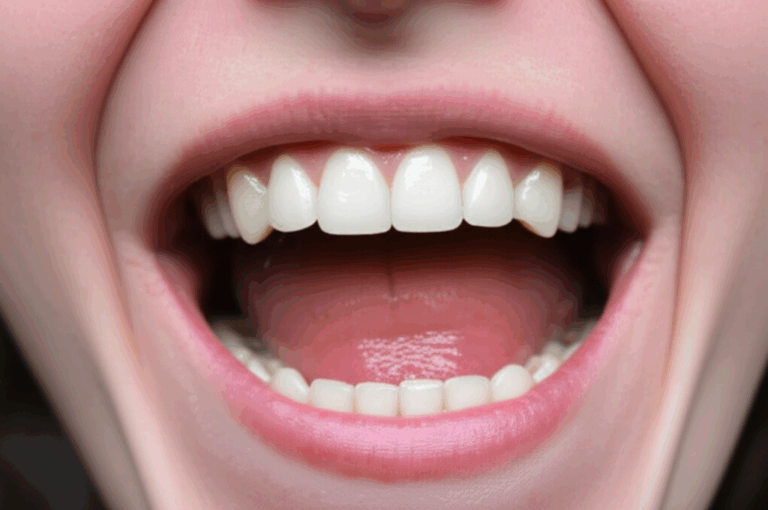
Can Dental Problems Cause Eye Issues? The Surprising Oral-Eye Connection
Have you ever had a stubborn toothache and, at the same time, felt a strange pain or pressure behind your eye? Maybe you noticed eye socket pressure when you had a sinus infection that seemed to start from a bad tooth. If you’ve ever wondered, "Is this just a coincidence, or can my teeth really affect my eyes?"—you’re asking a great and important question.
The answer is a clear yes.
It might sound odd, but the link between your mouth and your eyes is real. Your head is packed tight with many important parts—teeth, sinuses, nerves, and eyes—all close together and sharing space and connections. When there’s a problem in one spot, like a tooth infection, it can, in some cases, cause trouble in the area next to it—your eye.
Understanding how this works isn’t about scaring you; it’s about helping you catch problems early so you can take care of your teeth and your vision.
Table of Contents
- How Dental Infections Can Spread to Your Eyes: The Pathways
- Specific Dental Problems and Their Eye Complications
- Red Flag Symptoms: When to Get Help Right Away
- Diagnosis and Treatment: Working Together
- Prevention: How to Take Care of Your Mouth and Eyes
- Frequently Asked Questions
How Dental Infections Can Spread to Your Eyes: The Pathways
So, how can a problem in your mouth reach your eye? It’s all about how close everything is and how the parts in your head are connected. Here are three main ways this can happen: being close together, the infection spreading, and swelling in the body.
- Close Together: Everything’s Packed Tight
Think of your head like a crowded neighborhood. Your top back teeth (molars and premolars) sit right under your cheekbone sinuses, which are just below your eyes.
- Shared Nerves: There’s a big nerve called the trigeminal nerve that goes to your teeth, gums, sinuses, and eyes. If a tooth gets infected and this nerve gets upset, sometimes pain gets “referred” and you feel it in your eye even though the problem is with your tooth.
- Shared Blood Vessels: The veins in your face that drain blood from your teeth and eyes are connected. This means, in rare situations, germs from a tooth problem can travel to the area around your eyes or even deeper.
- Infection Spreading: Taking the Path of Least Resistance
A tooth that gets deeply infected can build up with pus, making a pocket full of germs called an abscess. If you don’t treat it, the germs look for any place to escape.
Just like a leak in your upstairs apartment can drip into the one below, a dental infection can move through thin bone to your cheekbone sinus, causing a sinus infection—and from there, it’s a short trip to the area near your eye. That’s how a toothache can sometimes turn into a serious eye problem.
- Body-Wide Swelling: Everything’s Connected
Sometimes, it’s not germs traveling, but your body reacting to long-term dental diseases, like gum disease (periodontitis).
Your body sees constant germs in your mouth as a problem and fights back by making proteins that cause swelling. These can travel anywhere in your body—including the eyes—causing swelling and possible problems.
Specific Dental Problems and Their Eye Complications
Not every little cavity means your eyes will hurt, but some dental problems are more likely to cause eye issues. Here’s a breakdown:
A. Tooth Abscess / Bad Tooth Infection
This is the most direct and risky link. A tooth abscess is a pus pocket at the root of a tooth. If it gets really bad, it can cause:
- Orbital Cellulitis: This is a big emergency. The infection moves from your tooth or sinus to the soft tissue behind your eye, inside the eye socket. Research shows that up to 10–17% of adult cases of orbital cellulitis start because of a dental problem.
- Symptoms: Bad pain in the eye (especially when moving it), bulging eye, double or blurry vision, fever, and swelling. If you have these, go to the ER right away.
- Periorbital Cellulitis: This means the infection is around the eyelid and skin around your eye, not inside the socket. It’s serious, too, but not as dangerous as orbital cellulitis.
- Cavernous Sinus Thrombosis (CST): A rare but life-threatening problem where a blood clot forms in a big vein behind your eyes. Dental infections can cause this when bacteria travel in facial veins. Symptoms are similar to orbital cellulitis but may be worse—like high fever, eye muscle problems, and confusion.
B. Sinus Infection Caused by a Tooth (Odontogenic Sinusitis)
Did you know about 10–25% of all long-term cheekbone (maxillary) sinus infections are from a dental problem? This can happen since your back top teeth roots are so close to your sinuses.
- Symptoms: Usually, there’s dull, nagging pain or pressure behind one eye. The inflamed sinus puts pressure near the eye and can cause discomfort, blurry, or double vision if nerves are bothered. It often feels like a normal sinus infection, but it won’t go away until the tooth issue is fixed.
C. TMJ Disorders (Jaw Joint Problems)
Your TMJ is the joint connecting your jaw and skull. If this joint or its muscles are strained or sore, you can feel pain that spreads. This is not an infection; it’s more of a muscle problem.
- Symptoms: People with TMJ problems often feel pain behind their eyes, eye tiredness, or even blurry vision. This happens because muscles used for chewing get tight, and that tension spreads. Headaches from TMJ tension are also often felt behind the eyes.
D. Gum Disease (Periodontal Disease)
The link between gum disease and eye problems is more about swelling in the whole body. If your gums are always sore and infected, it throws your body into a state of irritation.
- Whole-Body Link: New research is looking at how mouth swelling from gum disease might relate to eye inflammation, like:
- Uveitis: Swelling inside the eye.
- Glaucoma: Some studies say swelling and stress from gum disease might help glaucoma (damage to the nerve behind your eye) get worse.
E. Other Rare Connections
- Dental Cysts or Tumors: Rarely, a large lump from a tooth or jaw can push on nerves that go to the eye, causing pain or numbness.
- Dental Injury: A major injury to your tooth or jaw can harm nearby nerves, maybe causing your eye to twitch, go numb, or hurt.
- Problems After Dental Work: Sometimes, dental procedures can lead to hidden infections if a root canal or crown isn’t done well. This shows why proper dental work matters for long-term health.
Red Flag Symptoms: When to Get Help Right Away
It’s important to know the difference between mild, nerve-related pain and a real emergency. If you have a toothache plus any of these eye symptoms, go to the hospital right away:
- Sudden vision changes (blurry, double vision, or vision loss)
- Bulging eye(s)
- Can’t move your eye normally
- Severe eye pain, especially when moving your eye
- Fast-worsening swelling or redness around your eye
- High fever, chills, confusion, or severe headache with dental and eye symptoms
These mean the infection could be in your eye or even your brain—act fast to save your sight and even your life.
Diagnosis and Treatment: Working Together
If you come in with both mouth and eye symptoms, your dentist and your eye doctor need to work together.
How They Figure It Out
The Treatment Plan
The goal is to get rid of the infection’s source and help the eye heal.
- Fix the Tooth Problem: This has to come first. Treatment depends on the cause, but could include:
- Antibiotics: For serious cases, these are given directly into your vein (IV).
- Draining the Abscess: The dentist or surgeon must remove the pus.
- Root Canal: To clean out the infected tooth and save it.
- Pulling the Tooth: If it is too damaged, it has to be removed.
- Help for the Eye: The eye doctor addresses the eye trouble—maybe with medicine to lower swelling or surgery for serious cases.
Prevention: How to Take Care of Your Mouth and Eyes
The best way to avoid these scary problems is easy: take care of your teeth and gums. No need to panic—just be smart and proactive.
- Brush and Floss Well: Clean your teeth for two minutes, twice a day, and floss once a day.
- Don’t Skip Dental Visits: Go to the dentist every six months for cleaning and check-ups, so they can spot trouble early.
- Get Dental Problems Fixed Right Away: Don’t ignore tooth pain. It’s your body’s way of telling you something’s wrong. The sooner you take care of it, the better.
- Remember: It’s All Connected: Your mouth is part of your whole body, so caring for it helps protect not just your teeth, but your eyes, heart, and more.
Conclusion: Don’t Wait Or Ignore the Signs
The link between your mouth and your eyes is a reminder that all your body parts are connected. A toothache isn’t always just about your tooth—it can cause problems for your vision.
If you know how infections can spread, watch for warning signs, and take care of your teeth, you’re doing your best to keep both a healthy smile and clear sight. If you have pain in your tooth and weird eye symptoms at the same time, don’t tough it out—see a dentist and a doctor to find out what’s really going on. Both your teeth and your eyes matter!
Frequently Asked Questions (FAQs)
1. Can a tooth abscess cause permanent vision loss?
Yes, it’s possible. If an abscess spreads and leads to a serious infection near your eye (orbital cellulitis), swelling can squeeze the nerve that lets you see. If not treated quickly, damage can be permanent, leading to vision loss or blindness in that eye. This is why it’s an emergency.
2. How fast can a tooth infection spread to the eye?
It varies. Sometimes, a serious infection can reach the eye socket in just a few days. Other times, a slow problem might take weeks or months before it gets worse. The takeaway: don’t risk it. Any new eye problems with a toothache should be checked right away.
3. Should I see the dentist or eye doctor first?
If you have emergency symptoms, like bulging eyes, double vision, or vision loss, go to the ER right away. For less scary symptoms, like pain or pressure behind the eye with a toothache, start with your dentist—they can check your teeth and tell you if you need to see the eye doctor.
4. Is all eye pain from a tooth problem an emergency?
No, but it should always be checked out. Most often, it’s "referred pain"—a nerve sends pain from your tooth to your eye, but there’s no real danger to your sight. Still, only a dentist or doctor can tell for sure, so get checked.
5. Can jaw clenching affect my eyes?
Yes. If you clench or grind your teeth a lot, you overwork your jaw muscles. That tension can spread out and cause headaches and pain behind your eyes, or make your eyes feel tired and blurry sometimes.








